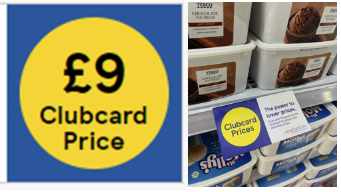Supermarket Wars II
Tesco (largely) loses appeal in dispute around Clubcard Prices signage:
“Tesco have copied the visual element of a blue square surrounding (among other material) a yellow circle, that is all they have done”
In March 2024, the Court of Appeal handed down its decision in relation to the much-discussed Lidl v Tesco case (Lidl Great Britain Limited & Anor v Tesco Stores Limited & Anor [2024] EWCA Civ 262). Our commentary on the first instance decision can be found here.
The dispute centred on Tesco’s use of a device (a yellow roundel on a blue background) in Clubcard Prices signage.
Lidl’s key registered trade marks (the “wordless” and “Lidl logo” marks)


Examples of Tesco’s Clubcard Prices signage

Background
At first instance, Lidl succeeded in claims of trade mark infringement, passing off and copyright infringement. Tesco failed in its counterclaim to revoke Lidl’s wordless mark on the grounds of non-use (at least in relation to relevant goods and services), but succeeded in a bad faith invalidation claim against the wordless mark.
In considering the claims of trade mark infringement and passing off, the judge was influenced strongly by the evidence before her, which included surveys, witness and expert testimony, as well as evidence of internal warnings within Tesco teams about potential confusion with Lidl. She found the evidence demonstrated both origin and price-comparison confusion on the part of consumers with the Lidl logo; that they had made a link between the Lidl logo and Tesco’s similar signage and interpreted the latter as communicating a (in some cases false) price-match-with-Lidl message, despite this not being Tesco’s intention. Evidence that Lidl had, in response to the Clubcard Prices promotions by Tesco, launched its own campaign to ‘correct’ such consumer perceptions was found by the judge to be particularly persuasive.
The judge rejected Tesco’s argument that it had “due cause” to use the signage because blue is an established part of its corporate branding and yellow has acknowledged visual impact in marketing.
The judge also found in Lidl’s favour in its copyright infringement claim, deciding that Lidl’s logos were entitled to copyright protection and that Tesco had copied a substantial part of them.
Lidl was able to successfully defend its registrations for the wordless marks against a challenge that they had not been put to genuine use. Although Lidl was only able to show the use with the LIDL name, the judge found that wordless mark was recognised as distinctive in its own right, and its distinctiveness was separate from, and unaffected by, the (also distinctive) word LIDL. Nevertheless, Tesco did succeed in its bad faith invalidation counterclaim that Lidl had, in an abuse of the trade mark registration system, applied to register the wordless mark without genuine intent to use it in that form. The judge held that registrations for the wordless mark were indeed intended as a “legal weapon” and, here again, placed weight on the (lack of) evidence to demonstrate that Lidl knew, or thought, that use of its Lidl logo amounted to use of the wordless mark (despite her finding, in rejecting Tesco’s non-use revocation claims, that it did!).
The Court of Appeal Decision
In summary, the Court dismissed Tesco’s appeal against the first-instance findings of trade mark infringement and passing off but allowed its appeal in relation to the finding of copyright infringement. It also dismissed Lidl’s appeal against the finding that registrations for the wordless mark were invalidly registered.
In his lead judgement, when discussing the issues of trade mark infringement and passing off, Arnold LJ repeatedly emphasised that the Court could only intervene with the first-instance judge’s findings of fact if they were “rationally insupportable”; the Court found that those findings, in particular in relation to consumers’ perception of price-matching, were open to the judge.
All three Court of Appeal judges appeared to agree that the issue of consumer confusion as to price-matching central to the case was, in Lewison LJ’s words, “at the outer boundaries” of the law around trade mark and passing off (that is, some distance away from protecting Lidl’s trade mark from consumer confusion as to origin) and that, had the case come before them at first instance, it might have been decided differently.
In relation to copyright infringement, the Court held that whilst Lidl’s logo was sufficiently original to be entitled to copyright protection, the scope of that protection was narrow and Tesco had not, in any case, copied the elements original to the work, as compared to previous iterations. In Arnold LJ’s words, “Tesco have copied the visual element of a blue square surrounding (among other material) a yellow circle, that is all they have done. In the case of the cropped and rectangular forms…they have not even done that.”
Finally, the Court dismissed Lidl’s appeal in relation to Tesco’s invalidation counterclaim against the wordless mark, pointing out that Lidl adduced no evidence as to either its intentions at the time of filing, nor to the reputation (if any) of the wordless mark at that time.
Comment
This decision demonstrates clearly how difficult it is to overturn findings of fact on appeal. The bar is high; an appeal Court will only intervene if those findings are “rationally insupportable”. It also provides a reminder of the persuasive potential of evidence from consumers of actual confusion, in guiding judges in their assessment of the perspective of the “average consumer”.
Much commentary has focussed on the trade mark infringement strand of this case, with many pointing out that Lidl may come to regret its success. It is not difficult to envisage how the findings, centring on marks sharing only shape and colour, could be weaponised against the discounter in relation to aspects of their own product packaging.
Nonetheless, Tesco’s success in its bad faith invalidation counterclaim is also an interesting aspect of the case with wide application, if less widely discussed. The decisions of both the High Court and Court of Appeal allow for registration of parts of a composite mark in some circumstances, even where those parts will not be used in isolation. This filing strategy may be appropriate where brand owners genuinely consider those parts are independently distinctive – and are recognised as such by consumers – in their own right. However, the upheld finding on bad faith demonstrates to both brand owners and their advisors the potentially fine line between good and bad faith; between obtaining broad and justifiable protection of trade marks intended for use, as distinct from defensive protection calculated primarily to prevent certain forms of trade mark use by other parties.
If the issues discussed in this Briefing Note are of interest, or raise questions, please contact the Greaves Brewster trade mark team for further information and advice.
This article should not be taken as legal advice, it is for guidance only.

